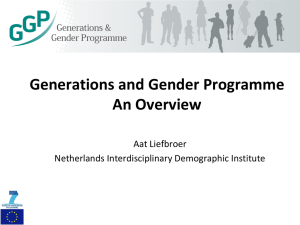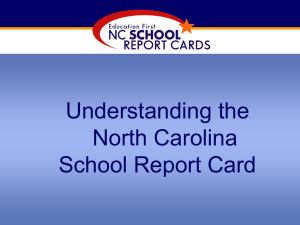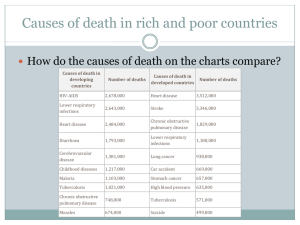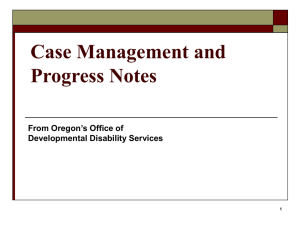LAS Links Pre Test Workshop Powerpoint
advertisement
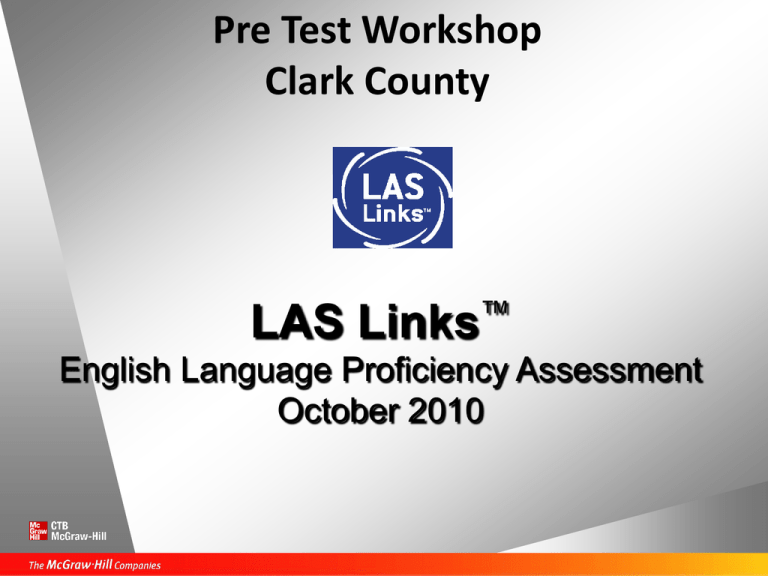
Pre Test Workshop Clark County LAS ™ Links English Language Proficiency Assessment October 2010 IMPORTANT NOTICE • This presentation provides information outlined in the “ English Language Proficiency Assessment Test Coordinator’s Manual (TCM) 2010-2011 Administration” • For the most current information and procedures for CCSD, please contact Bruce Clemmer, ELLP Director, Testing at 855-7771. 2 Your Nevada CTB/McGraw-Hill Team Lynne Czerwinski, Program Manager, Program Operations Minal Patel, Scoring Project Manager Elma N. Pineda-Raney, Ed.D., Senior Evaluation Consultant Geri Ray, MBA-HCM State Solutions Manager 3 Today’s Topics • • • • • • • • • • Overview Important Dates Who to Test Test Security Pre-test Activities Distribution of Test Materials Demographic Highlights Preparation for Testing Post-test Activities Tips for a Successful Testing Program 4 5 Who do I call with questions? The ELLP Coordinators are: Area 1 Brenda Daw Gail Welch 799-1719 x5324 799-1719 x5322 Area 2 Heath Horvat Penny Nicholson 799-0930 x5330 799-2160 x5205 Area 3/ESD Yesmi Rios 799-2658 x5327 Area 4 Barbara Badalewski Letitia Worth 799-4558 x5346 799-4558 x5343 DL/SSSD/Charter Schools Miriam B. Benitez 799-2137 x5043 Testing & Translation Svc. Bruce Clemmer 855-7771 x5369 6 Overview • The Nevada Department of Education (NDE) designated LAS Links™ as the English Language Proficiency Assessment for the state – Complies with NCLB requirements and measures students’ skills in Speaking, Listening, Reading, Writing and Comprehension – Used as the official AMAO* assessment – LAS Links, Form B, is to be used in 2010-2011 – Large Print and Braille test books are not available 7 *Annual Measurable Achievement Objectives CCSD Important Dates Phase I Secondary: October 25, 2010 – December 14, 2010 Phase II Elementary: October 25, 2010 – January 14, 2011 Phase III Elementary: December 6, 2010 – February 18, 2011 Testing windows Phase I Secondary: October 8, 2010 Phase II Elementary: October 8, 2010 Phase III Elementary: November 24, 2010 Barcode label delivery – October 22, (Phases I and II) November 22, ( Phase III) Test Materials Delivery (October 8, 2010) Phase I Secondary – January 13, 2011 Phase II Elementary – February 3, 2011 Phase III Elementary – February 24, 2011 Test Turn-in Location Phase I Secondary – TBD Phase II Elementary – TBD Phase III Elementary – TBD Report Delivery (Should be about four weeks after test turn-in) Henderson Convention Center Page 1 TCM 8 Who do I test? • • • • • • • • • Do not rely on the labels. Access the ELLP website: www.ccsd.net/ellp/ Select: “Student Lists” & “I agree”. Userid: ellpactive; password: seelists Select the “Weekly Student Lists” button in the upper left hand corner. Find your Area and scroll down to your school. Double click on the purple button. Test all students identified in Section I – Students to be tested on the ELPA. The list is updated weekly. Check periodically to see if students have been added. 9 EPS Codes Tested Not Tested AA AC AB AX AW BC BB BX BW WC WX WW EE CC *PA *These students must be administered the Placement Test to determine ELL status before the ELPA is administered. The ELPA is only administered to students who are eligible for ELL services. Page 21 TCM 10 Test Security • Test security is everyone’s job! – Keep all test materials secure at all times – Test security procedures may be found in the ELPA Guide on the ELLP website • Non-consumable test materials: – Student Books for grade spans 4-5, 6-8 and 9-12 – CDs, Cue Books and Examiner’s Guides • Consumable test materials: – Student Test/Answer Books for grade spans K-1 and 2-3 – Student Answer Books for grade spans 4-5, 6-8 and 9-12 Page 5 TCM 11 Pre-Test Activities • As soon as Form B materials arrive, verify packing list against materials received – Consumable materials will be delivered in packages of 10 or 25 – Verify quantities within packages • Inventory Form B materials remaining from previous test administration • Complete your Materials Receipt Verification form and fax to the attention of Bruce Clemmer at 7992132 • Inventory Form A materials and fax to the attention of Bruce Clemmer at 799-2132 (Appendix B in ELPA Guide – LAS Links Off-year Materials Inventory form) 12 CCSD Assessment Team • District Assessment Team – District Coordinator – Area ELLP Coordinator – School Site Test Coordinator – Teachers or anyone else authorized/trained to administer LAS Links 13 Assessment Team Guidelines • District and School Coordinators – Emphasize: Test security, physical condition of test materials, student demographics, importance of correct packaging of materials • Test Administrators – Emphasize: Test security, correct testing procedures – including bubbling 14 Test Materials to be shipped by CTB • Test Coordinator’s Kits (sent to schools) – Group Information Sheets – School Group List – Test Coordinator’s Manual • Student Barcode labels will be shipped separately to schools (October 22, and December 3, 2010) • Consumable test materials Testing Windows Phase I Secondary: October 25, 2010 – December 14, 2010 Phase II Elementary: October 25, 2010 – January 14, 2011 Phase III Elementary: December 6, 2010 – February 18, 2011 Test Materials Delivery Phase I: October 8, 2010/ Phase II Elementary: October 8, 2010 Phase III Elementary: November 14, 2009 15 Student Barcode Labels • • • • Labels are included in the Test Coordinator’s Kit One label per student Do not make marks on the label If you bubble any demographic information while using a barcode label, it will overwrite the barcode data. Page 6 TCM 16 Barcode Label Positioning • Apply student label in upper left corner • Label may be crooked, but must be within box • If a student does not have a label, bubble in all demographic information Page 7-8 TCM 17 Demographic Highlights • If student ID bar code label is not used: – Test Examiner must bubble demographic information on pages one and two • All hand bubbling must be reviewed for accuracy Pages 7-10 TCM 18 Demographic Grid Page One (p. 7-8 TCM) Demographic Descriptions • Ethnicity (7) – Mark only one ethnicity • Student ID Number (6) – Ten digits. Right justify and fill leading columns 0 0 5 3 2 8 6 4 5 7 with zeroes 20 Demographic Descriptions (cont.) • Home Language (8) – Not required by NDE. • Purpose of Test (9) – Fill in the bubble for Annual Assessment 21 Demographic Grid Page Two Pages 9-10 TCM Demographic Descriptions (cont.) • Date Testing Completed (10) – • Bubble and write in the date the student was tested Test Invalidation (11) and Test Exemptions (12) – – • Consult the district test coordinator before invalidating any test section No score will be given for the sections marked Absent (13) – – There are very few cases when it is appropriate to mark a student as absent for a test section In the case that a student was unable to complete all subtests prior to the end of the testing window, the student will be marked as absent for the missed subtest(s). 23 Demographic Descriptions (cont.) • USA School Enrollment (14) – Not required by NDE. • Mobility (15) – Not required by NDE. • Program Participation (16) – Not required by NDE. 24 Demographic Descriptions (cont.) • Special Education (17) – All Special Education students must be tested unless specifically stated otherwise in their IEP or 504 Plan. • Disability (18) – Fill in the appropriate circles for a student’s primary disability as stated in the student’s IEP or 504 Plan – Use the codes in the Examiner’s Guide (see next slide) – For Developmentally Delayed use the code that most closely matches the listed codes Check with your Special Ed Facilitator! 25 Disability Codes Code Disability Code Disability A Autism SED Serious Emotional Disturbance D Deaf LN Learning Disability HI Hearing Impairment SLI Speech or Language Impairment MU Multiple Disabilities TBI Traumatic Brain Injury OI Orthopedic Impairment VI Visual Impairment OHI Other Health Impairments ME Mental Retardation 26 Demographic Descriptions (cont.) • Accommodations (19) – For the ELPA only Special Education students may receive accommodations – Accommodations must be documented in writing in the IEP or 504 plan. Any accommodations provided must be recorded for each subtest taken. The only permissible accommodations are those listed in the Examiner’s Guide. 27 Accommodations Codes Code Assistance Given DC Clarify directions in English. RQE Read test questions and content in English. This is considered an accommodation only if it is used with test questions that are not normally read by the examiner. RPE Restate or rephrase questions in English. RSR Use a scribe to record student’s responses. SA Spelling aids provided, such as spelling dictionaries (without definitions), spell/grammar checkers, etc. ASM Mark responses in Student Book rather than in Student Answer Book (applies to grades 4-12 only). To submit student’s responses to CTB for scoring, school personnel must transfer all responses to the appropriate scannable Student Answer Books. RDNL Read directions in native language. 28 Preparation for Testing If you are a teacher or other licensed test examiner: – Identify students to be tested – Identify locations for each group if testing multiple classes – Prepare students for testing – Have a sufficient supply of #2 pencils available – Assemble all materials for quick distribution – Bubble demographic information and/or apply Student Barcode label – Administer the test following the Examiner’s Guide verbatim Page 11 TCM 29 Preparation for Testing (cont.) Answer Documents • Remind students to: – Make marks heavy and dark – Only use a #2 pencil – Erase all stray marks • Check documents to make sure that all demographic information has been bubbled and/or label is applied correctly – Scoring turn-around will be delayed if critical information is missing If students use a pen, scores may not be provided 30 Preparation for Testing (cont.) Testing Times • To give students who are English Language Learners every opportunity to demonstrate their proficiency in English, all portions of these tests are un-timed Skill Area Approximate Time Administration Mode Speaking 10 minutes Individual Listening 15 minutes Group or Individual Reading 35-45 minutes Group or Individual Writing 35-45 minutes Group or Individual Found in the Examiner’s Guide 31 CCSD: Post Test Activities Preparing Materials for Shipment CCSD Site Coordinator: • Check physical condition of documents • Complete purple Group Information Sheet (GIS) for each grade – Write in and bubble • In the Teacher Name field, provide the grade name – Example: First Grade or Six • Number of students tested and grade – School name and code will be pre-printed – Place on top of booklets or answer documents for each grade – GIS is scannable document; do not copy Page 14-15 TCM 32 Group Information Sheet Preprinted Pages 14-15 TCM You fill in CCSD: Preparing Materials for Shipment (cont.) CCSD Site Coordinator: • School/Group List — Fill in: – The name of the District Coordinator as the contact person (Bruce Clemmer) – Number of test documents enclosed by grade – The District Name, School Name and Code will be pre-printed on the School Group List – See sample p. 15 TCM 34 School/Group List Preprinted Pages 15-16 You fill in CCSD: Packaging at School Site • Place a Group Information Sheet on top of the first test for a grade level • The location for test turn-in will be the Henderson Convention Center. – Return all completed or partially completed answer books – Return all GIS, SGL and unused student labels • Non-consumable test materials and unused consumable test materials will be maintained in secure storage at the school site. Page 22 TCM 36 CCSD: Preparing Materials for Shipment (cont.) Prior to arriving at the test turn-in location: Failure to follow these directions may cause a delay in processing your answer documents. 1. Check physical condition of all answer documents. 2. Erase all stray marks, remove any foreign items such as paper clips, adhesive, notes, etc. 3. If you find any answer document marked with pen, its answers must be transferred to a new answer document using #2 pencil. 4. Any hand-bubbled data will overwrite the bar code label data. If the printed information on the bar code labels is to be used, erase all hand-bubbled student-identification information. 5. Complete and sign the inventory form (will be sent closer to turn in date) 6. Do not place the answer books in the envelopes; do not seal the envelopes. All tests will be reviewed at the test turn in location. Page 22 TCM 37 Tips for a Successful Program • Check shipment immediately upon receipt (at all levels) • Maintain test security • Emphasize importance of taking testing seriously • Schedule testing for mornings, wherever possible • Schedule testing on Tuesdays - Thursdays, whenever possible • Make sure that students are tested within the correct grade span • Make sure you are using Form B materials 39 Tips for a Successful Program (cont.) • Read Test Coordinator’s Manual and Examiner’s Guide • Make sure that all coding is correct • Make sure that there are no missing Group Information Sheets or School Group Lists • Contact the district-wide ELLP Test Coordinator if you have any questions 40 Your Partner in Assessment WEBSITE: www. ctb.com

